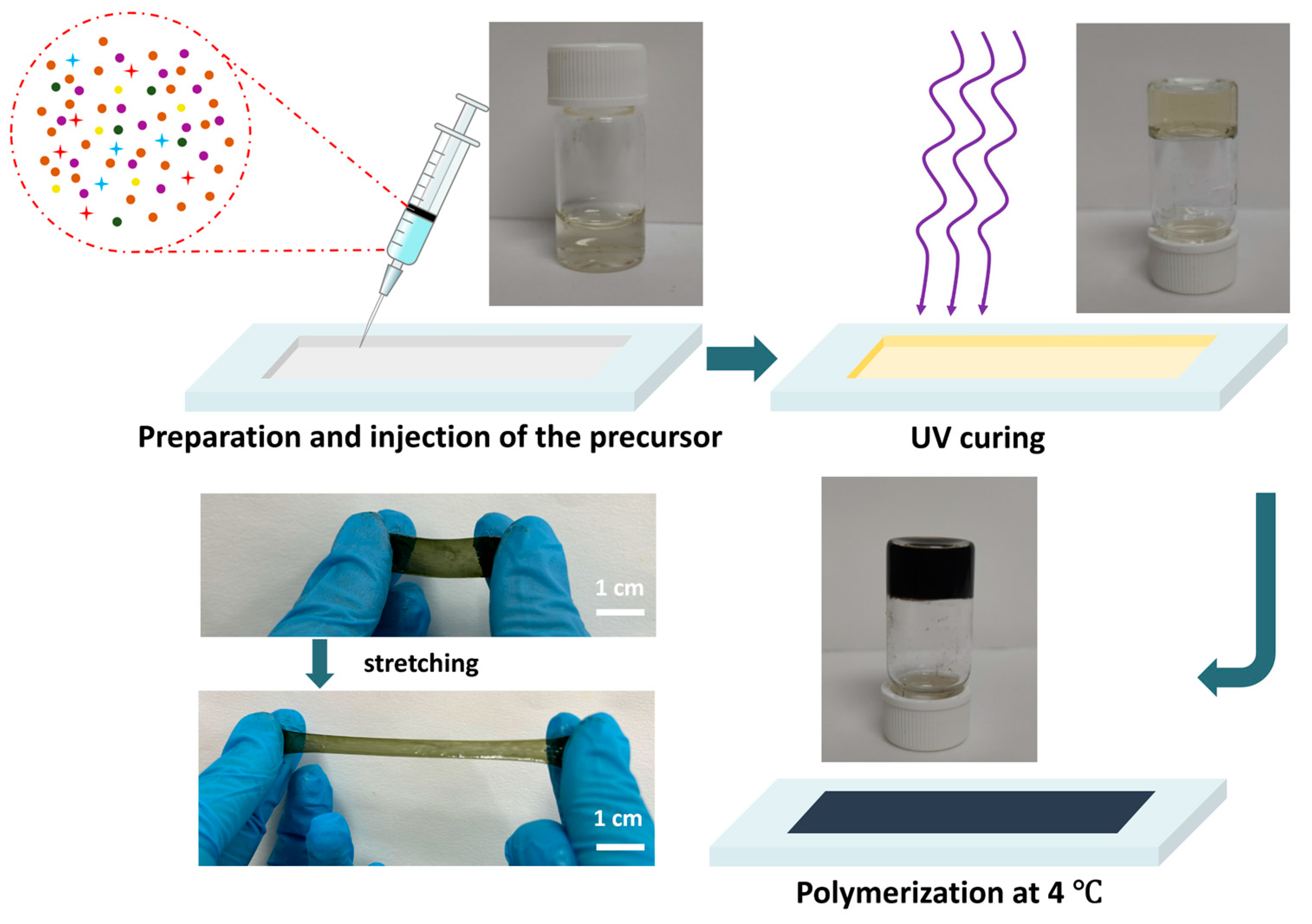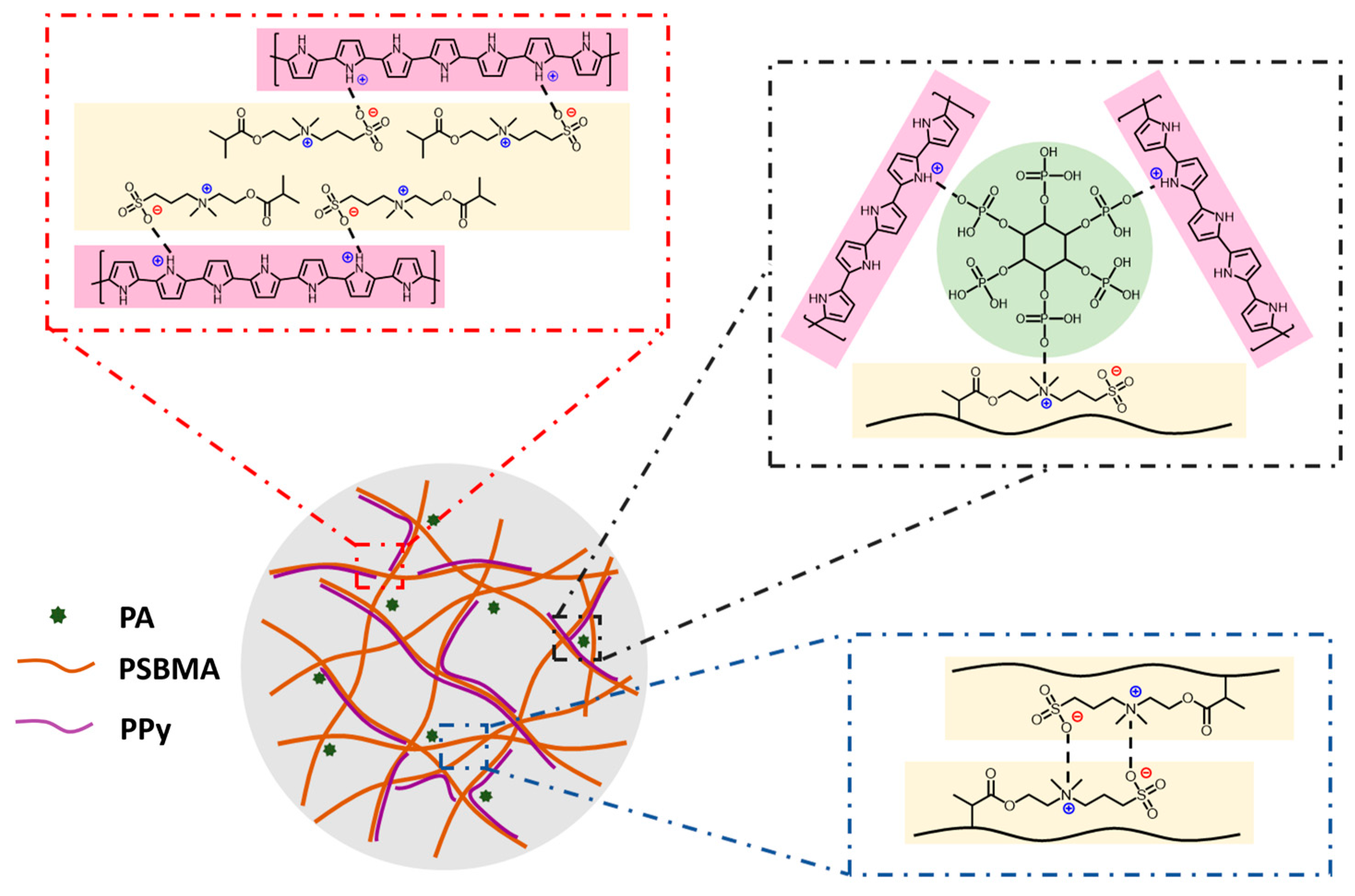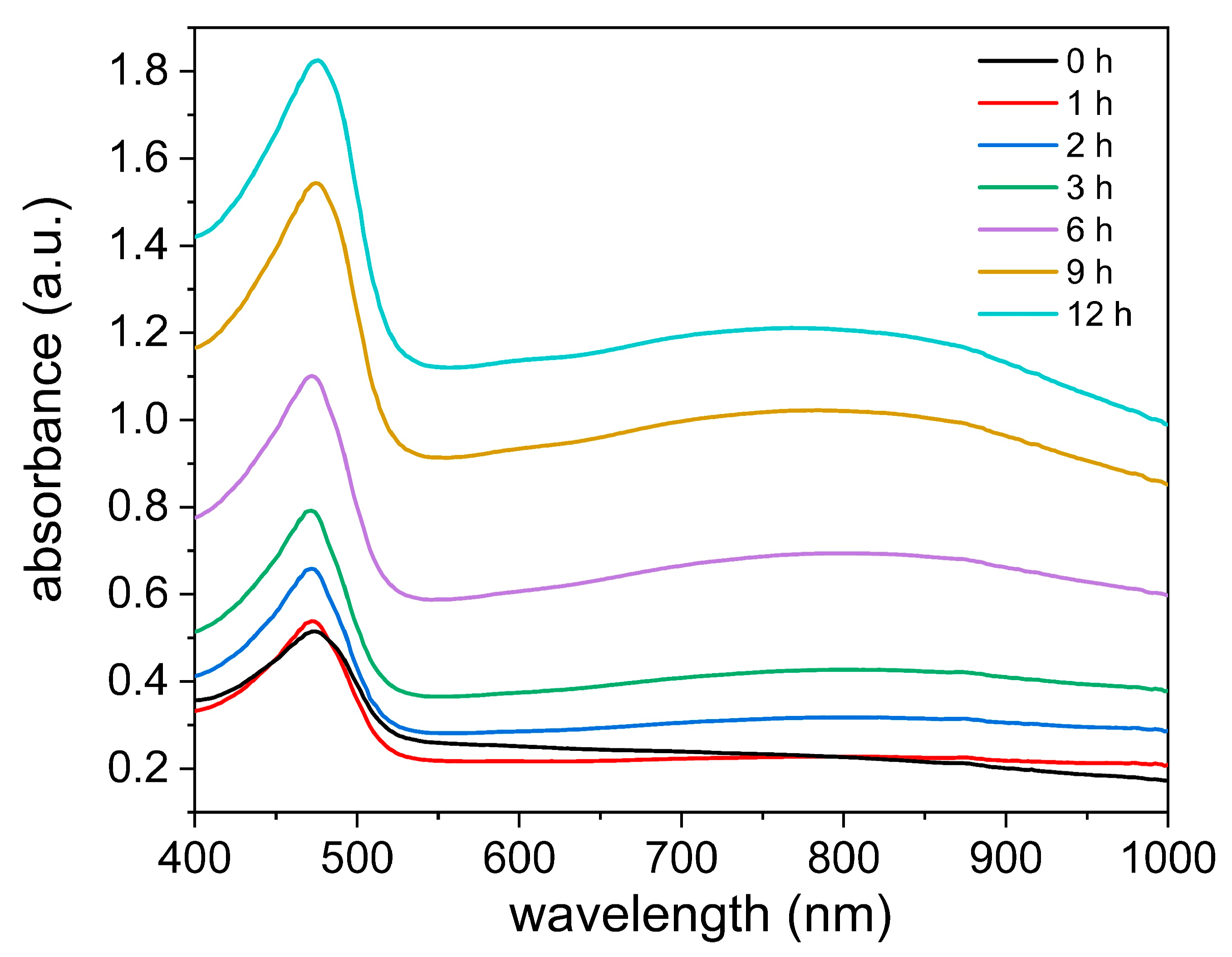Facile One-Pot Preparation of Polypyrrole-Incorporated Conductive Hydrogels for Human Motion Sensing
Abstract
:1. Introduction
2. Materials and Methods
2.1. Materials
2.2. Recipes of the Hydrogels
2.3. Characterization of Hydrogels
- The frequency was fixed at 0.5 Hz, while the strains were varied at 20%, 40%, and 60%.
- The strain was fixed at 20%, while the frequencies were varied at 0.25 Hz and 0.5 Hz.
- The strain and frequency were fixed at 15% and 0.5 Hz, respectively, with 100 cycles.
3. Results and Discussion
3.1. Synthesis of PPy/PA/PSBMA Hydrogels
3.2. Electrical and Mechanical Properties of PPy/PA/PSBMA Hydrogels
3.3. Sensing Performance of PPy/PA/PSBMA Strain Sensors
3.4. Extensibility of the One-Pot Preparation
4. Conclusions
Supplementary Materials
Author Contributions
Funding
Institutional Review Board Statement
Informed Consent Statement
Data Availability Statement
Conflicts of Interest
References
- Fu, F.; Wang, J.; Zeng, H.; Yu, J. Functional Conductive Hydrogels for Bioelectronics. ACS Mater. Lett. 2020, 2, 1287–1301. [Google Scholar] [CrossRef]
- Liu, N.; Ma, H.; Li, M.; Qin, R.; Li, P. Electroconductive Hydrogels for Bioelectronics: Challenges and Opportunities. FlexMat 2024, flm2.31. [Google Scholar] [CrossRef]
- Yuk, H.; Lu, B.; Zhao, X. Hydrogel Bioelectronics. Chem. Soc. Rev. 2019, 48, 1642–1667. [Google Scholar] [CrossRef]
- Namsheer, K.; Rout, C.S. Conducting Polymers: A Comprehensive Review on Recent Advances in Synthesis, Properties and Applications. RSC Adv. 2021, 11, 5659–5697. [Google Scholar] [CrossRef]
- Wang, C.; Rubakhin, S.S.; Enright, M.J.; Sweedler, J.V.; Nuzzo, R.G. 3D Particle-Free Printing of Biocompatible Conductive Hydrogel Platforms for Neuron Growth and Electrophysiological Recording. Adv. Funct. Mater. 2021, 31, 2010246. [Google Scholar] [CrossRef]
- Yuk, H.; Lu, B.; Lin, S.; Qu, K.; Xu, J.; Luo, J.; Zhao, X. 3D Printing of Conducting Polymers. Nat. Commun. 2020, 11, 1604. [Google Scholar] [CrossRef] [PubMed]
- Zhao, X.; Li, P.; Guo, B.; Ma, P.X. Antibacterial and Conductive Injectable Hydrogels Based on Quaternized Chitosan-Graft-Polyaniline/Oxidized Dextran for Tissue Engineering. Acta Biomater. 2015, 26, 236–248. [Google Scholar] [CrossRef]
- Qu, J.; Zhao, X.; Liang, Y.; Xu, Y.; Ma, P.X.; Guo, B. Degradable Conductive Injectable Hydrogels as Novel Antibacterial, Anti-Oxidant Wound Dressings for Wound Healing. Chem. Eng. J. 2019, 362, 548–560. [Google Scholar] [CrossRef]
- Derakhshankhah, H.; Eskandani, M.; Akbari Nakhjavani, S.; Tasoglu, S.; Vandghanooni, S.; Jaymand, M. Electro-Conductive Silica Nanoparticles-Incorporated Hydrogel Based on Alginate as a Biomimetic Scaffold for Bone Tissue Engineering Application. Int. J. Polym. Mater. Polym. Biomater. 2023, 73, 266–278. [Google Scholar] [CrossRef]
- Li, G.; Huang, K.; Deng, J.; Guo, M.; Cai, M.; Zhang, Y.; Guo, C.F. Highly Conducting and Stretchable Double-Network Hydrogel for Soft Bioelectronics. Adv. Mater. 2022, 34, 2200261. [Google Scholar] [CrossRef]
- Chen, Y.; Lu, K.; Song, Y.; Han, J.; Yue, Y.; Biswas, S.K.; Wu, Q.; Xiao, H. A Skin-Inspired Stretchable, Self-Healing and Electro-Conductive Hydrogel with a Synergistic Triple Network for Wearable Strain Sensors Applied in Human-Motion Detection. Nanomaterials 2019, 9, 1737. [Google Scholar] [CrossRef]
- Distler, T.; Polley, C.; Shi, F.; Schneidereit, D.; Ashton, M.D.; Friedrich, O.; Kolb, J.F.; Hardy, J.G.; Detsch, R.; Seitz, H.; et al. Electrically Conductive and 3D-Printable Oxidized Alginate-Gelatin Polypyrrole:PSS Hydrogels for Tissue Engineering. Adv. Healthcare Mater. 2021, 10, 2001876. [Google Scholar] [CrossRef] [PubMed]
- Han, Y.; Sun, L.; Wen, C.; Wang, Z.; Dai, J.; Shi, L. Flexible Conductive Silk-PPy Hydrogel toward Wearable Electronic Strain Sensors. Biomed. Mater. 2022, 17, 024107. [Google Scholar] [CrossRef]
- Zhang, Y.; Li, S.; Gao, Z.; Bi, D.; Qu, N.; Huang, S.; Zhao, X.; Li, R. Highly Conductive and Tough Polyacrylamide/Sodium Alginate Hydrogel with Uniformly Distributed Polypyrrole Nanospheres for Wearable Strain Sensors. Carbohydr. Polym. 2023, 315, 120953. [Google Scholar] [CrossRef] [PubMed]
- Cong, J.; Fan, Z.; Pan, S.; Tian, J.; Lian, W.; Li, S.; Wang, S.; Zheng, D.; Miao, C.; Ding, W.; et al. Polyacrylamide/Chitosan-Based Conductive Double Network Hydrogels with Outstanding Electrical and Mechanical Performance at Low Temperatures. ACS Appl. Mater. Interfaces 2021, 13, 34942–34953. [Google Scholar] [CrossRef] [PubMed]
- Chen, X.; Hao, W.; Lu, T.; Wang, T.; Shi, C.; Zhao, Y.; Liu, Y. Stretchable Zwitterionic Conductive Hydrogels with Semi-Interpenetrating Network Based on Polyaniline for Flexible Strain Sensors. Macromol. Chem. Phys. 2021, 222, 2100165. [Google Scholar] [CrossRef]
- Shin, S.; Hyun, J. Matrix-Assisted In Situ Polymerization of a 3D Conductive Hydrogel Structure. ACS Appl. Mater. Interfaces 2022, 14, 52516–52523. [Google Scholar] [CrossRef]
- Shi, W.; Han, G.; Chang, Y.; Song, H.; Hou, W.; Chen, Q. Using Stretchable PPy@PVA Composites as a High-Sensitivity Strain Sensor To Monitor Minute Motion. ACS Appl. Mater. Interfaces 2020, 12, 45373–45382. [Google Scholar] [CrossRef] [PubMed]
- Gan, D.; Han, L.; Wang, M.; Xing, W.; Xu, T.; Zhang, H.; Wang, K.; Fang, L.; Lu, X. Conductive and Tough Hydrogels Based on Biopolymer Molecular Templates for Controlling in Situ Formation of Polypyrrole Nanorods. ACS Appl. Mater. Interfaces 2018, 10, 36218–36228. [Google Scholar] [CrossRef]
- Li, Y.; Gong, Q.; Han, L.; Liu, X.; Yang, Y.; Chen, C.; Qian, C.; Han, Q. Carboxymethyl Cellulose Assisted Polyaniline in Conductive Hydrogels for High-Performance Self-Powered Strain Sensors. Carbohydr. Polym. 2022, 298, 120060. [Google Scholar] [CrossRef]
- Wang, C.; Zhang, J.; Xu, H.; Huang, C.; Lu, Y.; Cui, H.; Tan, Y. Chitosan-Driven Biocompatible Hydrogel Based on Water-Soluble Polypyrrole for Stable Human-Machine Interfaces. Carbohydr. Polym. 2022, 295, 119890. [Google Scholar] [CrossRef] [PubMed]
- Han, J.; Ding, Q.; Mei, C.; Wu, Q.; Yue, Y.; Xu, X. An Intrinsically Self-Healing and Biocompatible Electroconductive Hydrogel Based on Nanostructured Nanocellulose-Polyaniline Complexes Embedded in a Viscoelastic Polymer Network towards Flexible Conductors and Electrodes. Electrochim. Acta. 2019, 318, 660–672. [Google Scholar] [CrossRef]
- Song, M.; Yu, H.; Zhu, J.; Ouyang, Z.; Abdalkarim, S.Y.H.; Tam, K.C.; Li, Y. Constructing Stimuli-Free Self-Healing, Robust and Ultrasensitive Biocompatible Hydrogel Sensors with Conductive Cellulose Nanocrystals. Chem. Eng. J. 2020, 398, 125547. [Google Scholar] [CrossRef]
- Zhang, H.; Shen, H.; Lan, J.; Wu, H.; Wang, L.; Zhou, J. Dual-Network Polyacrylamide/Carboxymethyl Chitosan-Grafted-Polyaniline Conductive Hydrogels for Wearable Strain Sensors. Carbohydr. Polym. 2022, 295, 119848. [Google Scholar] [CrossRef] [PubMed]
- Tie, J.; Chai, H.; Mao, Z.; Zhang, L.; Zhong, Y.; Sui, X.; Xu, H. Nanocellulose-Mediated Transparent High Strength Conductive Hydrogel Based on in-Situ Formed Polypyrrole Nanofibrils as a Multimodal Sensor. Carbohydr. Polym. 2021, 273, 118600. [Google Scholar] [CrossRef]
- Zhao, L.; Zhang, H.; Guo, Z.; Yu, X.; Jiao, X.; Li, M.-H.; Hu, J. Natural Glycyrrhizic Acid-Tailored Homogeneous Conductive Polyaniline Hydrogel as a Flexible Strain Sensor. ACS Appl. Mater. Interfaces 2022, 14, 51394–51403. [Google Scholar] [CrossRef]
- Han, L.; Yan, L.; Wang, M.; Wang, K.; Fang, L.; Zhou, J.; Fang, J.; Ren, F.; Lu, X. Transparent, Adhesive, and Conductive Hydrogel for Soft Bioelectronics Based on Light-Transmitting Polydopamine-Doped Polypyrrole Nanofibrils. Chem. Mater. 2018, 30, 5561–5572. [Google Scholar] [CrossRef]
- Wei, D.; Wang, H.; Zhu, J.; Luo, L.; Huang, H.; Li, L.; Yu, X. Highly Stretchable, Fast Self-Healing, Responsive Conductive Hydrogels for Supercapacitor Electrode and Motion Sensor. Macromol. Mater. Eng. 2020, 305, 2000018. [Google Scholar] [CrossRef]
- Zhao, L.; Li, X.; Li, Y.; Wang, X.; Yang, W.; Ren, J. Polypyrrole-Doped Conductive Self-Healing Composite Hydrogels with High Toughness and Stretchability. Biomacromolecules 2021, 22, 1273–1281. [Google Scholar] [CrossRef]
- Wang, X.; Li, X.; Zhao, L.; Li, M.; Li, Y.; Yang, W.; Ren, J. Polypyrrole-Doped Conductive Self-Healing Multifunctional Composite Hydrogels with a Dual Crosslinked Network. Soft Matter 2021, 17, 8363–8372. [Google Scholar] [CrossRef]
- Han, J.; Zhou, C.; Wu, Y.; Liu, F.; Wu, Q. Self-Assembling Behavior of Cellulose Nanoparticles during Freeze- Drying: Effect of Suspension Concentration, Particle Size, Crystal Structure, and Surface Charge. Biomacromolecules 2013, 14, 1529–1540. [Google Scholar] [CrossRef] [PubMed]
- Kassim, A.; Basar, Z.B.; Mahmud, H.N.M.E. Effects of Preparation Temperature on the Conductivity of Polypyrrole Conducting Polymer. J. Chem. Sci. 2002, 114, 155–162. [Google Scholar] [CrossRef]
- Yuan, Z. High Sensitivity, Wide Range and Waterproof Strain Sensor with Inner Surface Sensing Layer for Motion Detection and Gesture Reconstruction. Sens. Actuators A Phys. 2024, 369, 115202. [Google Scholar] [CrossRef]
- Wang, Y.; Ma, W.-B.; Guo, L.; Song, X.-Z.; Tao, X.-Y.; Guo, L.-T.; Fan, H.-L.; Liu, Z.-S.; Zhu, Y.-B.; Wei, X.-Y. Phytic Acid-Doped Poly(Aniline-Co-Pyrrole) Copolymers for Supercapacitor Electrodes Applications. J. Mater. Sci. Mater. Electron. 2020, 31, 6263–6273. [Google Scholar] [CrossRef]
- Liao, Y.; Strong, V.; Chian, W.; Wang, X.; Li, X.-G.; Kaner, R.B. Sulfonated Polyaniline Nanostructures Synthesized via Rapid Initiated Copolymerization with Controllable Morphology, Size, and Electrical Properties. Macromolecules 2012, 45, 1570–1579. [Google Scholar] [CrossRef]
- Chen, Y.; Yin, Z.; Huang, D.; Lei, L.; Chen, S.; Yan, M.; Du, L.; Xiao, R.; Cheng, M. Uniform Polypyrrole Electrodeposition Triggered by Phytic Acid-Guided Interface Engineering for High Energy Density Flexible Supercapacitor. J. Colloid Interface Sci. 2022, 611, 356–365. [Google Scholar] [CrossRef] [PubMed]
- Leonavicius, K.; Ramanaviciene, A.; Ramanavicius, A. Polymerization Model for Hydrogen Peroxide Initiated Synthesis of Polypyrrole Nanoparticles. Langmuir 2011, 27, 10970–10976. [Google Scholar] [CrossRef] [PubMed]
- Hsu, C.F.; Zhang, L.; Peng, H.; Travas-Sejdic, J.; Kilmartin, P.A. Free Radical Scavenging Properties of Polypyrrole and Poly(3,4-Ethylenedioxythiophene). Curr. Appl. Phys. 2008, 8, 316–319. [Google Scholar] [CrossRef]
- Şarkaya, K.; Yildirim, M.; Alli, A. One-step Preparation of Poly(NIPAM-pyrrole) Electroconductive Composite Hydrogel and Its Dielectric Properties. J. Appl. Polym. Sci. 2021, 138, 50527. [Google Scholar] [CrossRef]
- Liu, H.; Yang, L.; Dou, B.; Lan, J.; Shang, J.; Lin, S. Zwitterionic Hydrogel-Coated Cotton Fabrics with Underwater Superoleophobic, Self-Healing and Anti-Fouling Performances for Oil-Water Separation. Sep. Purif. Technol. 2021, 279, 119789. [Google Scholar] [CrossRef]
- Chen, Q.; Li, S.; Zhao, W.; Zhao, C. A Rapid-Triggered Approach towards Antibacterial Hydrogel Wound Dressing with Synergic Photothermal and Sterilization Profiles. Biomater. Adv. 2022, 138, 212873. [Google Scholar] [CrossRef] [PubMed]
- Huang, Y.; Mu, L.; Zhao, X.; Han, Y.; Guo, B. Bacterial Growth-Induced Tobramycin Smart Release Self-Healing Hydrogel for Pseudomonas Aeruginosa -Infected Burn Wound Healing. ACS Nano 2022, 16, 13022–13036. [Google Scholar] [CrossRef] [PubMed]
- Handorf, A.M.; Zhou, Y.; Halanski, M.A.; Li, W.-J. Tissue Stiffness Dictates Development, Homeostasis, and Disease Progression. Organogenesis 2015, 11, 1–15. [Google Scholar] [CrossRef] [PubMed]








| Samples | PA (wt%) | Pyrrole (wt%) | Conductivity (mS/cm) |
|---|---|---|---|
| M3Py5 | 0.8 | 0.5 | 1.20 |
| M3Py10 | 1.6 | 1 | 1.85 |
| M3Py15 | 2.4 | 1.5 | 2.49 |
| M3Py20 | 3.2 | 2 | 2.27 |
| M3PA5 | 0.8 | 0 | 0.65 |
| M3PA10 | 1.6 | 0 | 0.89 |
| M3PA15 | 2.4 | 0 | 0.99 |
| M3PA20 | 3.2 | 0 | 1.07 |
| Samples | MBAA (wt%) | Pyrrole (wt%) | Elongation at Break (%) | Young’s Modulus (kPa) |
|---|---|---|---|---|
| M2Py15 | 0.2 | 1 | 325 | 11.08 |
| M3Py15 | 0.3 | 1 | 203 | 28.08 |
| M4Py15 | 0.4 | 1 | 155 | 37.42 |
| M5Py15 | 0.5 | 1 | 109 | 78.90 |
| Recipes | Hydrogel Monomer | Photo Initiator | CP Monomer | Oxidizing Agent |
|---|---|---|---|---|
| a | AAm | 2959 | Pyrrole | H2O2 |
| b | AA | LAP | Pyrrole | H2O2 |
| c | AAm and AA | LAP | Pyrrole | H2O2 |
| d | HEMA | 2959 | Pyrrole | H2O2 |
| e | SBMA | APS | Pyrrole | APS |
| f | SBMA | 2959 | Aniline | H2O2 |
Disclaimer/Publisher’s Note: The statements, opinions and data contained in all publications are solely those of the individual author(s) and contributor(s) and not of MDPI and/or the editor(s). MDPI and/or the editor(s) disclaim responsibility for any injury to people or property resulting from any ideas, methods, instructions or products referred to in the content. |
© 2024 by the authors. Licensee MDPI, Basel, Switzerland. This article is an open access article distributed under the terms and conditions of the Creative Commons Attribution (CC BY) license (https://creativecommons.org/licenses/by/4.0/).
Share and Cite
Zhao, Z.; Liu, J.; Lv, J.; Liu, B.; Li, N.; Zhang, H. Facile One-Pot Preparation of Polypyrrole-Incorporated Conductive Hydrogels for Human Motion Sensing. Sensors 2024, 24, 5814. https://doi.org/10.3390/s24175814
Zhao Z, Liu J, Lv J, Liu B, Li N, Zhang H. Facile One-Pot Preparation of Polypyrrole-Incorporated Conductive Hydrogels for Human Motion Sensing. Sensors. 2024; 24(17):5814. https://doi.org/10.3390/s24175814
Chicago/Turabian StyleZhao, Zunhui, Jiahao Liu, Jun Lv, Bo Liu, Na Li, and Hangyu Zhang. 2024. "Facile One-Pot Preparation of Polypyrrole-Incorporated Conductive Hydrogels for Human Motion Sensing" Sensors 24, no. 17: 5814. https://doi.org/10.3390/s24175814








